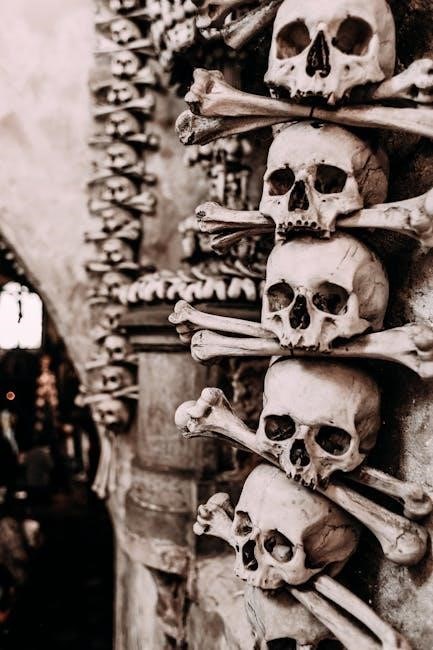John Donne, a renowned English poet and cleric, penned Death Be Not Proud in 1609, first published in 1633. This sonnet masterfully personifies death, challenging its perceived power and exploring themes of mortality, eternal life, and spiritual resilience, offering profound insights into human existence and faith.
1.1. Biographical Background of John Donne
John Donne, born in 1572 and died in 1631, was a prominent English poet, satirist, and Anglican cleric. Known for his metaphysical poetry, Donne served as Dean of St. Paul’s Cathedral. His works, including Death Be Not Proud, reflect a transition from secular to religious themes, blending intellectual depth with emotional intensity, leaving a lasting legacy in English literature.
1.2. Historical Context of the Poem
Death Be Not Proud was written in 1609, during a period of religious and philosophical transformation in England. Donne, an Anglican cleric, crafted the poem amid the cultural shifts of the early 17th century. The work reflects the metaphysical style of the time, blending theology with personal reflection. The era’s fascination with mortality and the afterlife deeply influenced Donne’s exploration of death’s nature and humanity’s spiritual journey.
1.3. The Significance of the Title “Death Be Not Proud”
The title “Death Be Not Proud” challenges death’s intimidating image, urging it not to be arrogant. Donne uses it to diminish death’s power, framing it as a temporary state rather than an end. This phrase encapsulates the poem’s central theme of mortality’s limits and the promise of eternal life, reflecting Donne’s belief in spiritual triumph over physical demise through faith.

Structure and Form of the Sonnet
John Donne’s Death Be Not Proud follows the Shakespearean sonnet structure, consisting of 14 lines with a rhyme scheme of ABAB CDCD EFEF GG. The poem’s meter is predominantly iambic pentameter, creating a rhythmic and structured framework that enhances its thematic depth and philosophical argumentation.
2.1. The Use of the Shakespearean Sonnet Structure
John Donne’s Death Be Not Proud adheres to the Shakespearean sonnet structure, comprising 14 lines with a rhyme scheme of ABAB CDCD EFEF GG. This traditional form provides a structured framework for Donne’s philosophical argument, allowing him to explore complex themes within a disciplined yet expressive format. The sonnet’s adherence to form underscores its intellectual rigor and theological depth.
2.2. Metrical Pattern and Rhyme Scheme
The poem follows a consistent iambic pentameter, with each line containing ten syllables and a rhythmic pattern of unstressed followed by stressed syllables. The rhyme scheme adheres to the Shakespearean model, ABAB CDCD EFEF GG, creating a harmonious flow that complements the sonnet’s structured argument. This metrical and rhymic precision enhances the poem’s musicality and reinforces its thematic coherence.
2.3. The Role of Personification in Addressing Death
Donne employs personification by addressing Death as a proud and formidable entity, stripping it of its intimidating aura. By giving Death human qualities, Donne challenges its authority, diminishing its fearsome reputation. This literary device enables a direct, confrontational tone, allowing Donne to argue against Death’s perceived power, emphasizing its subordinate role in the divine plan and the promise of eternal life.
Themes and Motifs in the Poem
Central themes include mortality, eternal life, and the use of paradox to challenge Death’s authority, offering assurance of spiritual transcendence beyond physical demise.
3.1. The Theme of Mortality and the Transience of Life
Donne confronts mortality directly, asserting that death, often feared, is merely a natural phase of life. He diminishes its might by highlighting its inevitability and universality, suggesting life’s transience as a reason to seek eternal peace and divine grace, thus transforming fear into acceptance and hope.
3.2. The Concept of Eternal Life and Afterlife
Donne’s poem underscores the belief in an afterlife, framing death as a temporary state rather than an end. He argues that death’s power is an illusion, as it serves a divine purpose, leading souls to eternal life. The poem’s Christian perspective emphasizes spiritual triumph, where death becomes a mere transition, highlighting the soul’s ultimate victory and union with God.
3.3. The Use of Paradox to Confront Death
Donne employs paradox to challenge death’s authority, calling it “mighty and dreadful” yet asserting it is “not so.” He argues death serves a divine purpose, transitioning souls to eternal life, thus diminishing its power. This paradox underscores life’s continuity, reframing death as a natural process rather than an end, emphasizing its role in God’s plan and the soul’s ultimate triumph.

Literary Devices and Stylistic Elements
Donne’s poem masterfully uses personification, alliteration, and imagery to convey deep themes. Irony and symbolism enrich the text, while rhetorical questions engage readers, enhancing the emotional impact.
4.1. The Employment of Alliteration and Imagery
Donne skillfully employs alliteration and imagery to enrich the poem’s emotional depth. Alliteration, as seen in “mighty and dreadful,” enhances rhythm and emphasizes death’s perceived power. Vivid imagery, such as “thou art not so,” challenges death’s intimidation, creating a stark visual contrast between its fearsome reputation and its true, lesser nature, ultimately undermining its authority and reinforcing themes of divine judgment and mortality’s inevitability.
4.2. The Impact of Irony and Symbolism
Donne’s masterful use of irony and symbolism underscores the poem’s central argument. Irony emerges when death is called “mighty and dreadful,” yet revealed as powerless. Symbolism, particularly in personifying death as a bringer of sleep, diminishes its terror, implying it is not an end but a transition. These elements reinforce the poem’s themes of mortality’s illusion and the triumph of eternal life over death’s perceived dominion.
4.3. The Use of Rhetorical Questions to Engage the Reader
Donne employs rhetorical questions to provoke reflection, such as “Why dost thou bragg?” which challenges death’s authority. These questions engage readers by fostering a direct dialogue with death, diminishing its intimidating image. By questioning death’s power, Donne invites readers to reconsider their fears, emphasizing the futility of death’s boasts and reinforcing the poem’s message of spiritual triumph and eternal life’s promise. This technique heightens the poem’s emotional and philosophical impact.

Analysis of Specific Lines and Their Meaning
Donne’s lines, like “Death, be not proud,” delve into theological paradoxes, challenging death’s authority and emphasizing its limitations, while affirming the hope of eternal life through spiritual triumph.
5.1. The Opening Lines and Their Theological Implications
The poem begins with a bold address to death, “Death, be not proud,” challenging its authority. Donne employs theological paradoxes, asserting death’s might is an illusion. He argues death serves God, not wielding true power, as it cannot kill the soul. This opening reflects Donne’s Christian beliefs, emphasizing resurrection and eternal life, thus diminishing death’s dreadfulness and highlighting its transient nature in divine plan.
5.2. The Middle Stanzas and the Argument Against Death’s Power
The middle stanzas dismantle death’s authority, arguing it is not the true destroyer but a temporary state. Donne writes, “thou art not so,” emphasizing death’s limits. He portrays death as a “rest and sleep,” a natural phase, not an end. This underscores Christianity’s view of death as a transition to eternal life, thus stripping it of its terrifying power and reducing it to a mere illusion of finality.
5.3. The Concluding Couplets and Their Spiritual Resolution
The poem’s final lines, “Death, thou shalt die,” deliver a defiant and hopeful conclusion. Donne asserts death’s impermanence, framing it as a temporary state rather than an end. The couplets resolve the spiritual conflict by emphasizing eternal life’s triumph, offering solace and reassurance. This paradoxical statement redefines death’s power, transforming it into a transition toward divine existence, thus comforting the reader with faith’s promise.

The Poem’s Relevance in Modern Times
Death Be Not Proud remains universally relevant, offering timeless reflections on mortality and hope. Its exploration of death’s inevitability and the promise of eternal life continues to resonate, providing comfort and philosophical depth to contemporary audiences grappling with existential questions.
6.1. The Universality of the Theme of Death
Death, as explored in Donne’s poem, transcends time and culture, speaking to humanity’s shared experience of mortality. The universal fear and acceptance of death make the poem’s themes enduring, connecting readers across generations. Donne’s address to death as a personified entity underscores its relatability, making the poem a timeless reflection on human existence and the afterlife.
6.2. The Poem’s Influence on Contemporary Literature
John Donne’s “Death Be Not Proud” has profoundly influenced contemporary literature, inspiring modern poets and writers to explore themes of mortality with metaphysical depth. Its personification of death and use of paradox continue to resonate, encouraging fresh perspectives on universal human experiences. Donne’s unique style and theological insights remain a cornerstone for literary works addressing death and the afterlife.
6.3. The Application of Donne’s Philosophy in Modern Society
Donne’s philosophy in “Death Be Not Proud” offers timeless wisdom, encouraging modern society to view death as a natural transition rather than an end. His themes of hope, resilience, and the afterlife provide comfort and meaning, influencing contemporary discussions on mortality, grief, and spirituality. Donne’s ideas continue to inspire introspection and reassurance, bridging the gap between existential fears and the promise of eternal life.
John Donne’s Death Be Not Proud leaves an enduring legacy, offering profound insights into mortality and eternal life. Its message of hope and resilience continues to inspire readers, affirming the triumph of the human spirit over death’s shadow.
7.1. The Enduring Legacy of “Death Be Not Proud”
Death Be Not Proud remains a timeless masterpiece, influencing literature and philosophy. Its exploration of mortality and faith continues to resonate, offering solace and introspection. Donne’s work transcends centuries, inspiring contemporary writers and thinkers, ensuring its relevance in modern discourse on death and the afterlife.
7.2. The Poem’s Message of Hope and Resilience
Through its powerful imagery and paradoxical arguments, Death Be Not Proud conveys a message of hope and resilience. Donne asserts that death is not an end but a transformation, offering comfort to the bereaved. This perspective uplifts readers, emphasizing the possibility of eternal life and the triumph of the human spirit over mortality.
7.3. The Importance of Studying Donne’s Works Today
Studying Donne’s works, like Death Be Not Proud, remains vital for understanding timeless themes of mortality, faith, and resilience. His mastery of metaphor, paradox, and complex imagery offers insights into human experience. Donne’s exploration of theology and philosophy continues to inspire contemporary thought, making his poetry a rich resource for literary and spiritual enrichment in modern times.
